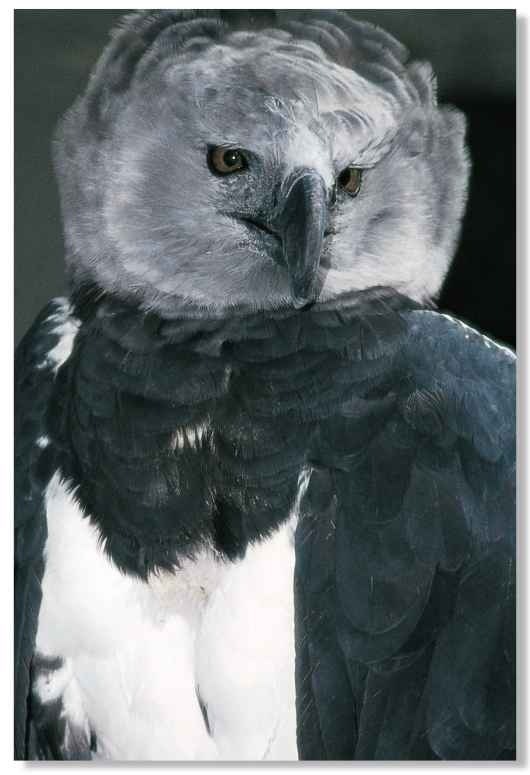ORDER
Falconiformes
FAMILY
Accipitridae
GENUS & SPECIES
KEY FEATURES
• The heaviest bird of prey, with the largest feet
and talons of any eagle
• Strong enough to snatch adult monkeys and sloths from the treetops in midflight
• pairs mate for life and raise a single chick once every three years
• its blend of brute force and ultra-sharp reflexes makes it one of the top rainforest predators
WHERE IN THE WORLD?
Thinly distributed from the southern tip of costa Rica through the Amazon Basin to northern Argentina; has vanished from many former haunts and is now classed as endangered

LIFECYCLE
Casting a sinister shadow over the rainforests of tropical America, the American harpy eagle terrorizes hapless animals that forage in the shifting sunlight of the high canopy.
HABITAT
The American harpy eagle is found in the extensive tropical rainforests of South and Central America. The eagle spends most of its time high in the canopy and nests only in the tallest trees, such as the giant kapok or silk-cotton trees.
Like most other powerful predators, the American harpy
eagle is naturally rare, as each pair hunts over a territory of up to 20 sq. miles. But new research suggests that the species occupies smaller territories in Panama and Venezuela and can survive in patches of forest bordering savannah, agricultural land and human settlements.
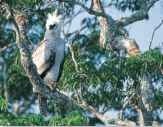
A High born
The harpy eagle lives and breeds in lofty branches.
This eagle can take 3 days to digest a meal, and may kill only twice a week.
A young harpy eagle may return to breed in the tree where it was born, as long as the tree is unclaimed by its parents or other eagles.
The heaviest bird of prey on record is a female harpy eagle that weighed 27 lbs.
The harpy eagle is named after the harpies — monstrous half-woman, half-bird predators of classical Greek mythology.

BEHAVIOR
The harpy eagle leads a solitary existence. Even when breeding, the male and female hunt and roost separately, with the female staying on the nest at night to brood the eggs or chick while her mate rests in a tree nearby. Encounters with other eagles are rare, but the female’s larger size enables her to defend her nest from other males should the need arise.
For such a large bird, the harpy eagle usually goes unnoticed as it perches statue-still and silent, alert for signs of either prey or intruders. While it is perched, the eagle’s dark upperparts are hard to spot in the dappled light of the forest.The harpy eagle usually only reveals itself by spreading its wings to reveal the pale breast feathers.
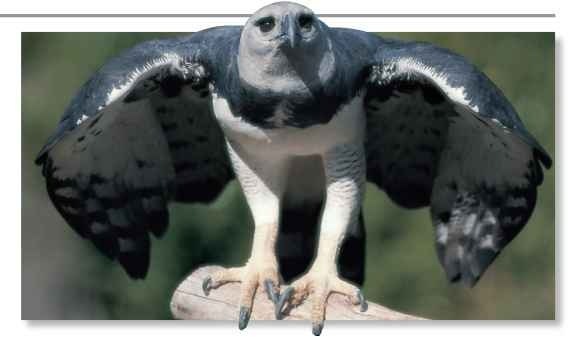
A Lone ranger
Ever alert, the harpy eagle watches over its home range from a lofty vantage point and patrols it from the air.
FOOD & HUNTING
The American harpy eagle is one of the most aerobatic of all eagles. Spotting its prey from a lookout, it launches out and swoops in at speeds of up to 48 mph. Broad, slotted wings allow it to twist and turn through narrow gaps in the canopy. The eagle may even roll upside down at the last moment before reaching up with its talons, and ripping its victim away with barely a check in its flight speed.
The harpy eagle hunts monkeys, sloths and tree-living porcupines and anteaters. It also preys on lizards, snakes, macaws and other large birds, and sometimes hunts pigs and rodents on the ground.
THE MONKEY SNATCHER

1 Scan
Perched on a dead tree rising over the forest canopy, a harpy eagle scans all around for potential prey.

2 Swoop
The eagle spots a troop of woolly monkeys raiding a fruiting tree. It takes off to mount a surprise attack

3 Strike
Without warning, the eagle smashes through the tree’s outer foliage and sinks its talons into a monkey’s back.
4 Success!
The spine-snapping impact kills the monkey, and the eagle carries off its prize to eat at leisure.
CONSERVATION
Most conservation bodies, including the IUCN (World Conservation Union), class the harpy eagle as regionally endangered. Huge swaths of rainforest have been felled in much of its range.As this bird nests only in tall trees, the growth found in some partially cleared areas cannot substitute for mature forest. However, new studies suggest that pairs can make do with compact hunting grounds fairly close to cultivated land, provided they can survive the farmers’ guns.
BREEDING
Little is known about the breeding habits of the harpy eagle, as its nests are so inaccessible. It is thought they form stable pairs that stay together for the breeding season and possibly for life. Each pair builds a nest of large sticks, lined with leaves and animal hairs, in the crown of a tree 130-160′ above the ground.They appear to use the same site regularly, refurbishing the old nest and gradually building it up until it is over 6.5′ across.
The female harpy eagle lays two eggs, several days apart. Like most eagles, the second egg serves as an “insurance policy’The elder; and therefore stronger; chick grabs nearly all the food brought to the nest, so the weaker chick soon starves. Only if the first chick dies does the younger one survive.The juvenile depends on its parents for a further 10 months, demanding J food from them even when it is able to fly.
Grounded for now After 2 months, the chick is the size of a turkey but still has a covering of down.

PROFILE
American Harpy Eagle
The harpy eagle’s split-second reflexes, needle-sharp talons and a massive, hooked bill leaves unwary animals with little chance of escape.
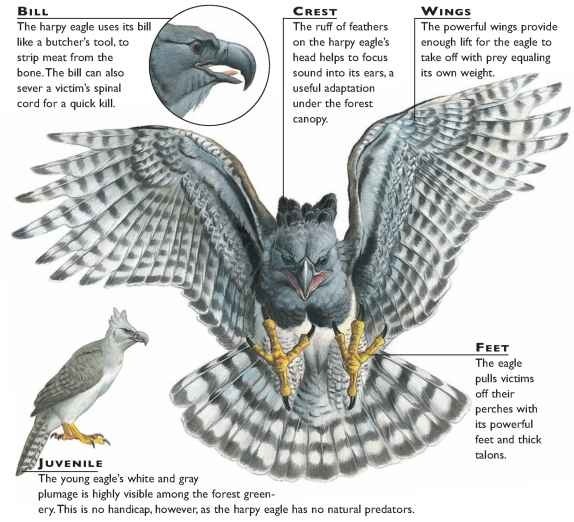
CREATURE COMPARISONS
The harpy eagle shares its name with another spectacular bird of prey that lives in New Guinea. Like its American counterpart, the New Guinea harpy eagle (Harpyopsis novaeguinae) scans the canopy of tropical rainforests for medium-sized prey, such as tree kangaroos, but it also hunts in clearings. However the New Guinean species has a slimmer build, smaller bill and shorter wingspan, and never exceeds 36″ in length.
With its brown and gray plumage, the New Guinea harpy eagle is less conspicuous than its American cousin. It is more often heard than seen, having a distinctive, far-carrying cry
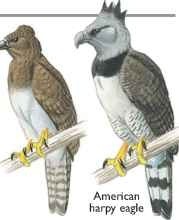
New Guinea harpy eagle
| VITAL | |
| STATISTICS | |
| ( Weight | Average 11 lbs.; female heavier than male |
| 1 I Length |
36-52″ |
| Wingspan | 7.5′ |
| Sexual Maturity | 4-6 years |
| Breeding Season | Varies by habitat |
| Number of Eggs Incubation Period |
1-2 About 55 days - |
| Breeding Interval | 3 years (rarely 2 years) |
| Typical Diet | Tree-dwelling mammals, birds, reptiles; occasionally rodents, reptiles, peccaries on the ground |
| Lifespan | Up to 30 years |
RELATED SPECIES
• There are 3 other harpy eagles: the New Guinea harpy eagle, Harpyopsis novaeguinae, Philippine eagle, Pithecophaga jefferyi, and Guiana crested eagle, Morphnus guianensis. Like the American harpy eagle, each is the only species in its genus. Harpy eagles belong to the large family Accipitridae, which also has 53 other eagle species, as well as buzzards, kites, harriers and hawks. All accipitrids hunt live prey.
